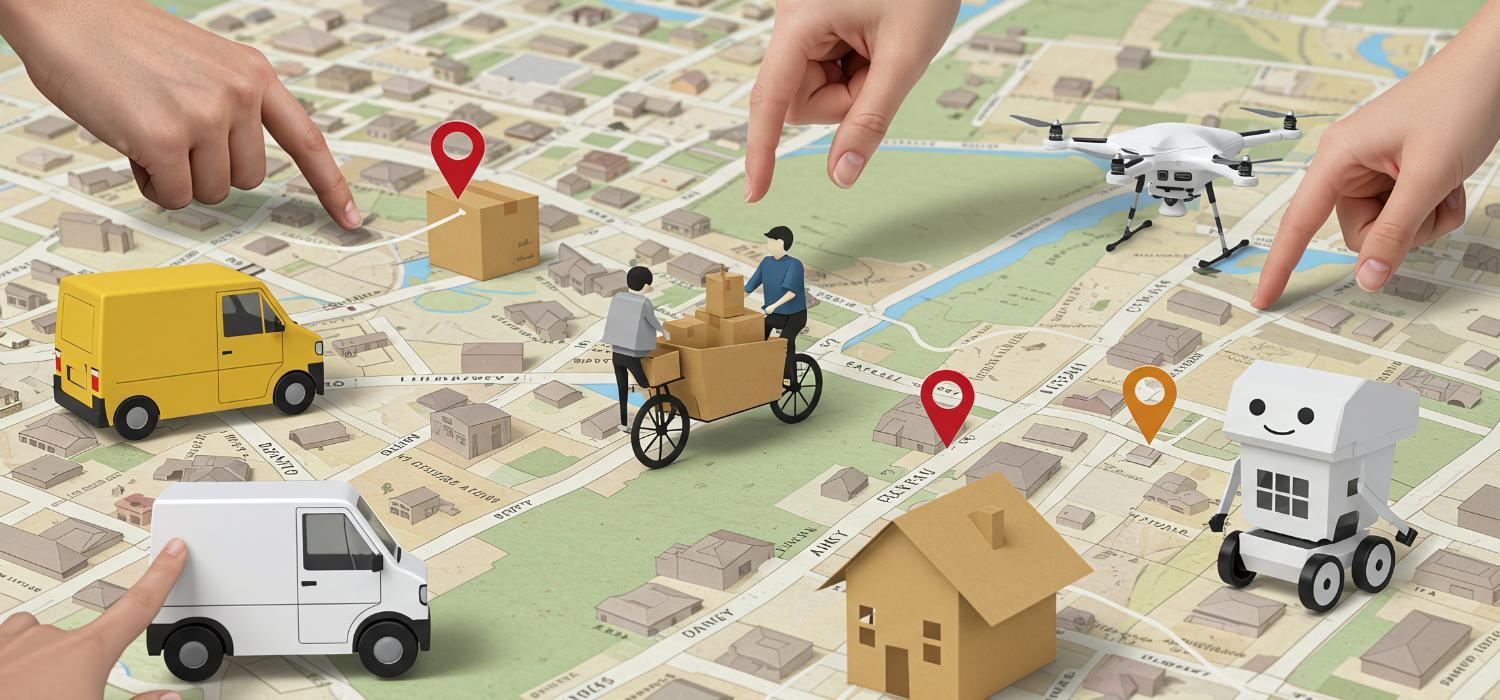Traffic, pollution, vans parked in the most unlikely places. Have we described a situation that sounds familiar? It is because more and more cities, in Italy and elsewhere, are facing these problems linked – also – to the issue of urban logistics and the increase in eCommerce deliveries.
Suffice it to say that 900,000 deliveries are made every day in the capital, handled by 25,000 vehicles, almost all of them diesel. The result? A swarm of couriers clogging up the streets, slowing down traffic and worsening air quality. This was how the phenomenon was described in an article in Corriere della Sera published last March, but it is only a reflection of a trend that is now widespread in all large cities: “the widespread development of door-to-door eCommerce, which has led to a fragmentation of deliveries, to the detriment of a rationalisation and sharing of deliveries”. A ‘red alert’ that calls for new, more effective and sustainable urban mobility strategies.
Among the most promising solutions is cycle logistics, a delivery model that utilises cargo bikes, e-bikes and two-wheelers to reduce traffic congestion and cut emissions related to urban deliveries. Let us therefore analyse the main benefits, but also the critical issues and future prospects of cyclo-delivery.
What is Cycle logistics
Cycle logistics is an alternative transport system that uses cargo bikes – i.e. bicycles with a large cargo compartment – and e-bikes with trailers to deliver goods, especially in urban areas.

Compared to traditional logistics, cycling therefore reduces the use of vans and lorries for deliveries in the city, thereby lowering emissions and increasing the efficiency of logistics operations, facilitating capillary distribution in city centres and at the same time mitigating the critical issues that cities face today.
But let’s go in order and look in more detail at all the benefits of cycling.
The benefits of cycling
Adopting a cycling model offers, as mentioned above, numerous advantages both in environmental terms and in terms of the efficiency and economic sustainability of logistics operations. Here are the main advantages.
1. Traffic reduction
One of the most noticeable and appreciable aspects of cycling is its ability to relieve city traffic.
Because of their agility, cargo bikes can move easily through congested streets, avoiding traffic jams and slowdowns. Unlike vans, which are forced to stop in traffic, make difficult manoeuvres and search for parking space to make a delivery, cargo bikes can travel in bicycle lanes, pass through pedestrian or restricted traffic zones (ZTL) and take side roads to destinations that would be difficult or impossible for a truck to reach. This results in shorter delivery times and more efficient logistics services, and also has a positive impact on the consumer experience, as we will see in more detail in the following points.
There is also a further aspect that should not be underestimated: as city traffic decreases, the quality of life in urban centres improves and safety for pedestrians and cyclists increases, who are thus less exposed to the risk of road accidents.
2. Greater environmental sustainability
Another of the most obvious benefits of cycling is the significant positive impact on the environment.
Cargo bikes and e-bikes, despite their larger loading space compared to a traditional bicycle, are powered by electric motors or simply by muscle power, reducing CO2 emissions almost completely – to be more precise, we are talking about 90 per cent – compared to a traditional van, making this a much more environmentally friendly solution.
In addition, the adoption of electric vehicles helps to reduce noise pollution, another factor that contributes to making cities less liveable today.
3. Operational efficiency
As mentioned above, operational efficiency is another tangible advantage of the cycle.
In fact, companies that have already adopted cycling have seen an improvement in delivery times of 30-50% compared to motor vehicles. This is mainly due to the possibility of avoiding congested traffic and less parking difficulties, as we have seen. This greater agility therefore allows more deliveries to be made in a shorter time, improving the punctuality and reliability of logistics operations.
Also contributing to greater efficiency is the possibility of easily integrating this solution with urban micro-hubs strategically located in the city, as well as with Lockers and Pick-up Points throughout the territory. Urban micro-hubs are small sorting and storage areas strategically located in city centres, where parcels can be separated and redistributed more efficiently, thus ensuring optimal handling of goods. Lockers and Pick-up Points located in accessible locations for consumers, on the other hand, allow users to collect their parcels at their convenience, avoiding the hassle (and the wait!) of home deliveries.
Integrating cycling with these solutions therefore reduces the number of individual trips required to make deliveries, optimising routes and increasing logistical efficiency.
4. Cost Reduction
Another benefit of cycling, certainly no less important than the previous ones, concerns the reduction of operating costs.
As low-maintenance vehicles, cargo bikes significantly reduce maintenance costs compared to conventional motorised vans. In addition, there is no need to buy fuel or face parking expenses. Cargo bikes are not subject to restricted traffic zone (ZTL) restrictions, allowing couriers to easily enter city centres without paying extra charges.
The adoption of cycling can therefore result in significant savings for companies, both in terms of direct and indirect costs. In a context of increasing competition and cost-consciousness, this solution is therefore not only environmentally friendly, but also cost-effective.
5. Improving the experience
Finally, a further benefit of cycling is the improvement of the customer experience.
Because of its speed, reliability and sustainability, it has the potential to significantly improve the quality of service offered to consumers, ensuring greater loyalty.
It should also not be forgotten that more and more consumers are sensitive to the environmental impact of their choices and tend to prefer companies that adopt sustainable solutions. Faster and less polluting deliveries increase customer satisfaction. This can not only strengthen customer loyalty but also attract new ones.
Challenges and critical issues in cycling
In spite of its many advantages, however, cycling presents certain challenges that we cannot ignore, because only by addressing them can we ensure an increasingly effective implementation of cycling.
1. Load limitations
Although cargo bikes are, as we have seen, a more sustainable and efficient solution for urban deliveries, one of the main limitations concerns the load capacity of cargo bikes.
Although these vehicles are specially designed to transport a larger amount of goods than a conventional bicycle, their capacity is still smaller than that of vans and trucks. This implies that more cargo bikes may be needed to handle large volumes of deliveries, which increases logistical complexity.
2. Ensuring the security of transported goods
Another aspect that affects – and not a little – both merchants and customers is the issue of the security of transported goods.
Although cargo bikes are optimised for transporting goods, they do not offer the same protection as vans or trucks. Goods transported by bike are therefore necessarily more exposed to the risks of theft, damage from falls or impacts, and adverse weather conditions such as rain or wind.
To ensure the security of parcels and the protection of goods, it is therefore crucial to equip cargo bikes with appropriate protection systems, such as closed containers, anti-theft systems and waterproof covers. Furthermore, it may be necessary to invest in technological solutions, such as real-time monitoring of bikes and parcels, to ensure security along the entire route.
3. Deficient urban infrastructure
Another issue related to cycling concerns urban infrastructure, which in many Italian cities is not yet sufficiently developed to support an efficient transport system based on two-wheeled vehicles.
In fact, not all cities have an adequate number of bicycle lanes, and the existing ones are not always designed to guarantee safe and efficient logistics operations. In addition, many urban areas lack dedicated spaces for loading and unloading goods, which is essential to avoid traffic congestion and to facilitate the operation of cargo bicycles. Another important challenge is the need for an efficient and well-developed network of logistics micro-hubs, without which the efficiency of bicycle deliveries could be compromised. Cargo bikes are in fact limited in their range, so it is essential to have sorting points that can reduce the distance between the starting point and the final destination. The lack of such facilities in many cities, as well as the difficulty in finding suitable and well-connected spaces, may hinder the realisation of a truly effective cycling system.
In other words, without adequate infrastructure planning that includes the construction of safe cycle paths, the creation of areas for parking bicycles and sorting goods, and more efficient management of urban spaces, the cycling model could face major difficulties in its development and large-scale adoption
Bologna, a success story for cycling
A successful example of the implementation of innovative solutions for sustainable urban logistics, such as cycling, is the Municipality of Bologna.
With the support of GEL Proximity, the city launched an experimental project, within the European URBANE project, based on the creation of agnostic hubs strategically positioned in the city centre. These hubs, accessible to different logistics operators and designed to optimise the management of last-mile deliveries, facilitate the transfer of goods from traditional vehicles to other electric vehicles or even to cargo bikes.
The technology provided by GEL Proximity plays a crucial role as an orchestrator of logistics processes, integrating the various actors in the transport chain, monitoring delivery flows and analysing different data sources in real time. Find out more here.
GEL Proximity, your technology partner for cycling
GEL Proximity is the leading platform on the market for managing omnichannel data and information related to urban logistics. We are therefore able to offer the necessary tools to make cycling a concrete and accessible reality for merchants and local administrations.
Cloud technology makes it easy to use multiple applications to manage the entire logistics flow through one centralised software. With the orchestrator engine it is possible to manage urban spaces, automated lockers, identify cut-off rules, manage the occupancy required for the storage of goods, connect operators and couriers as well as dozens of local last milers and cargo bikers.
What are you waiting for, the future of logistics is sustainable: it’s time to pedal towards positive change. Contact us now!













